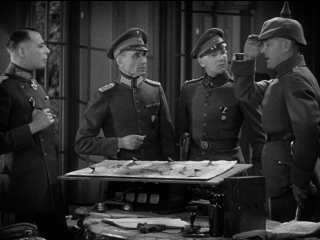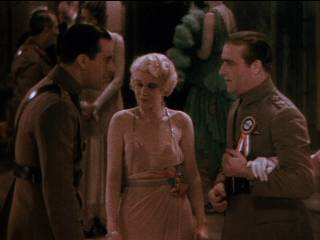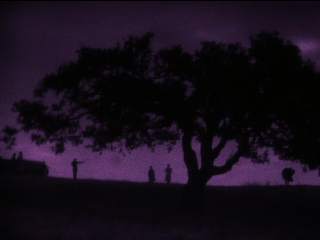Film Review: Hell's Angels (1930)
Hell's Angels (1930)
directed by Howard Hughes, dialog directed by James Whale
©1930 Caddo Company, Renewed 1958 Hughes Tool Co.
Restored by the UCLA Film and Television Archive
Frames in this review are taken from the Universal DVD ©2004 Universal
Studios.
There's no trailer on the Universal DVD for Hell's Angels, but
it doesn’t matter. No trailer could possibly sell the film as well as
Martin Scorsese's biopic
The Aviator. Some of the most spectacular scenes in this film
are excerpted in The Aviator, most notably, the Zeppelin
bursting into flame in a lengthy hand-colorized shot, as well as the
dizzying climatic dogfight, featuring perfectly choreographed aerobatics
and a surprisingly believable head-on collision of two planes.

Notice the emphasis on the aviation scenes, as the story is mere melodrama. Just look at the list of characters: the unflappable Oxford collegian and his cowardly brother, their German pal, the blonde bombshell who is (gasp) shockingly unfaithful, the cold-blooded Zeppelin captain, even the Red Baron von Richthofen himself. Well, the German pal finds himself fighting against his friends, the Zeppelin captain does something suitably callous while bombing London, the brothers find themselves in a love triangle, and there's a dogfight to end all dogfights.
On August 16, 1930, Mordaunt Hall wrote in the New York Times:
"Thrilling flashes of airplane fighting in the clouds and magnificent
scenes of ... bombing ... counteract silly episodes ..." (p. 13)
Three-quarters of a century later, A. O. Scott wrote a capsule
summary of his original review on NYTimes.com: "And, it should be
said, the aerial combat sequences are vivid and impressive. But rarely
has a movie so technically proficient been so conceptually bankrupt."
Chop up the plot, pour it in the character stew, stir, and the result is
the World War I analog of the absurd big-explosions flick
Pearl Harbor.
Actually, these two films have more in common than the trite plot. Both were extremely expensive, so much so that (hundreds of) millions at the box office barely brought them to break-even. Both included a substantial amount of real aerial footage combined with various special effects techniques, both juggled a vast array of film technologies for effect — Hell's Angels has a reel shot in two-color Technicolor, while Pearl Harbor had a few dozen prints struck in Technicolor's briefly-revived dye-transfer process.

But don't let the comparison to Pearl Harbor scare you away, because Hell's Angels is the better movie. So what if an Oxford residential college ends up with the wild antics of an American fraternity house, or that the actor playing the German character Karl had a British accent, while the three British main characters spoke with American accents? This is a blockbuster of the old Hollywood style, complete with a ten-minute intermission and exit music to add to the roadshow effect. Hell's Angels manages to keep the viewer entertained and attentive, and if it moves slowly at times, the aerial scenes more than make up for it. The characters deliver some silly and obvious lines, but occasionally there's something that matters, as when the coward brother Monte Rutledge's (Ben Lyon) rants against the bigshots who pull the strings in the brutal machinery of war.
Ultimately the film ends by depicting a successful Allied ground attack,
made possible by the heroes' bombing mission. There are also appeals to
loyalty and duty: in camp as Monte expresses his doubts to his brother
Roy (James Hall), and when they are taken prisoner and questioned about
the upcoming offensive. These doubts reflect the profound
disillusionment of the 1920s about the Great War. Hell's Angels
was released in the same year as Lewis Milestone's anti-war film classic,
All Quiet on the Western Front. A few years after that, the influential book
Merchants of Death
would be published, excoriating the armaments
industry from conspiring to profit from the death and misery of millions
of young men.
A Mixed Bag
The quality of the acting is very mixed. James Hall and Ben Lyon both
put out a gee-willickers performance that's the deliberate public image
of the Hollywood dream factory, and ham it up to tears at the death
scene. John Darrow presents an intentionally weak Karl; how did such a
crybaby get into Oxford? (In the tone of a fourteen year-old: "But
suppose England comes in? Why Roy, that'd be horrible! I never could do
that; why, I love England!") Lucien Prival plays the Prussian general
role with almost as much glee as Erich von Stroheim, though this Prussian
isn't that evil (except perhaps as inspiration for Dr. Evil in
Austin Powers).
Jean Harlow does all right with what little is in the script about her
character, being straightforwardly and appropriately naughty.
Occasionally, though, her voice begins to resemble the parody of silent
film actors in
Singin' in the Rain. It’s clear that this talking picture thing is
very new, and the actors are not quite prepared for it. In the last days
before the Production Code began to be strictly enforced, Harlow's lines
are laced with double-entendres that have just the barest veneer of
respectability, and the costume designer puts her in breathtaking gowns
that, under the right lighting, are skin-colored in both black-and-white
and Technicolor.

The film could’ve been much better if care had been taken with the dialog. Many of the elements of a good film are present, and the melodramatic story is not without its charms. But this is the early sound era, and Hell's Angels is hardly alone in talking for the sake of talking.
The best parts of the film were filmed without synchronized sound. The Zeppelin bombing scene is dubbed in German but is essentially silent with intertitles, and other intertitles remain in the film here and there. The sped-up movement and the sparse wording create an entirely different aesthetic, one that’s more sweeping and less trivial, leaving room for the viewer to add in his own feelings. The same applies to the English scenes that were shot silent and then overdubbed. In the silent scenes, there's more camera movement, more motion within the frame, more dynamic angles. One wishes that enough film had survived to piece together the silent version of Hell's Angels. With some judicious editing and rewriting of intertitles, the spectacular aerial scenes and the doubts about the war would easily make Hell’s Angels a better film than the first Academy Award winner for Best Picture: Wings.
Technical Aspects
The flying scenes in the film are truly worth every penny. Real life always looks so much better than process or model shots, and this film is filled with real stunt flying. When the two aerial fleets engage for the dogfight, the sheer precision of the aerobatics is dazzling. Planes are zipping every which way, flying within mere yards of other planes. Just think of how many falling leaves the fliers had to do just for the scenes showing a plane out of control! The camera planes came very close to the stunt planes and remained quite steady.
There's a feeling of fluidity and realism to the shots of the giant V
formation, with the planes bobbing around as the pilots make subtle
adjustments to stay in formation. The aerial gunnery in the dogfight
sequence feels immediate and fresh, as though we really were looking over
the gunner's shoulder as enemy fighters headed in our direction. And
Howard Hughes was absolutely right about the clouds (refer to the scene
in
The Aviator ) — they truly do make the scenes more intense by
adding a greater sense of motion.
In contrast, the earlier Zeppelin scene is more stately, with its model
shots and fluffy white clouds of dry ice. With the engine telegraph and
the propeller, it gives the feeling of being in a U-Boat. And when it
explodes, pow! That sudden burst of red in a blue-tinted night scene
makes for a great effect. (Flames are a good choice for
hand-colorization, as they hide any imperfections.) When the flames fill
the frame and the metallic structure falls apart, the whole picture is
tinted red, and could almost pass for the real thing over Lakehurst, New
Jersey when the
the Hindenburg caught on fire seven years later.

There's more color tinting throughout the film: night scenes are tinted
blue, and a wordless duel at the crack of dawn is a lovely lavender. The
two-color Technicolor feels underused; the art direction generally leaves
a predominance of one color, with the other used sparingly. For example,
a red-draped dance hall would have a few olive military uniforms, and a
background of trees is punctuated by rosy faces and Helen's gown. It's
not as spectacular as the Turner/Thames Silents presentation of
Ben-Hur (1925) , which actually had white and black as well as red
and green. Here, there is only red and green, and both are
low-saturation. Granted, there may have been some electronic color
rebalancing done to Ben-Hur. Here, the Technicolor blends in
better, as though it were like the Zeppelin scene — tinted with some
hand-painted stencil colorization.
The film undoubtedly tries to be accurate about aviation, given Howard Hughes' interest in the field, but there are some obvious military and continuity errors elsewhere. Karl is called up to the 18th Army Corps, which is fine since it's a Reserve corps, but he turns up in a Zeppelin with a big L32 on the side, marking it as a Navy airship! Monte sets out to write a pre-combat letter to Helen at a bar, is told "Pen and ink on the table," and sits down to pick up a pencil. It's also puzzling how blowing up a munitions dump behind the front lines on the day of an offensive leads to victory, in which line upon line of densely packed soldiers manage to lose only a dozen men while attacking the German trenches. In real life, machine guns and ordinary rifle fire from frontline ammunition stocks should have easily mown down the attackers. This is the First World War, not the Seven Years' War. Likely these errors are the result of Howard Hughes' fixation on the flying scenes — the dialog scenes were directed separately by James Whale, and they feel spliced-in, very different in style.
All in all, Hell's Angels is a rather enjoyable example of the type of film spectacle that was extraordinarily expensive then and would be prohibitively costly today. Were it not for the flying, the film could've been shot in a couple of weeks for far less money. It's far superior to most early-sound films, and with some allowance for the melodramatic story, remains quite watchable today.
The UCLA Restoration

The neat thing about any UCLA restoration of a studio film is that technical information is often publicly available in the Film and Television Archive's catalog. The film was apparently restored in 1989 from three sources. The base print came from Howard Hughes' estate through Universal, some sound and picture came from George Eastman House, and the Technicolor reel 4 is duplicated from UCLA's own print of a shorter cut.
The picture quality is fairly good. Very little process photography is involved, except for a brief interlude in the Zeppelin sequence, so the grain is not so noticeably except for the dissolves. Although two-color Technicolor is fragile and is often filled with splices, here it looks to be very well-preserved. Much of the material looks pristine (perhaps it was wet-gated); the rest has some minor scratches and both positive and negative dust.
A few non-optical scenes look a touch soft, and the presence of male leads make this seem unintentional — perhaps these were sections that were printed in from the Eastman House print. Of course, two-color Technicolor is expected to be soft and grainy. The audio is also quite good, with very little noise and distortion. The restoration has basically resulted in the complete film at almost the same quality as a well-preserved studio film.